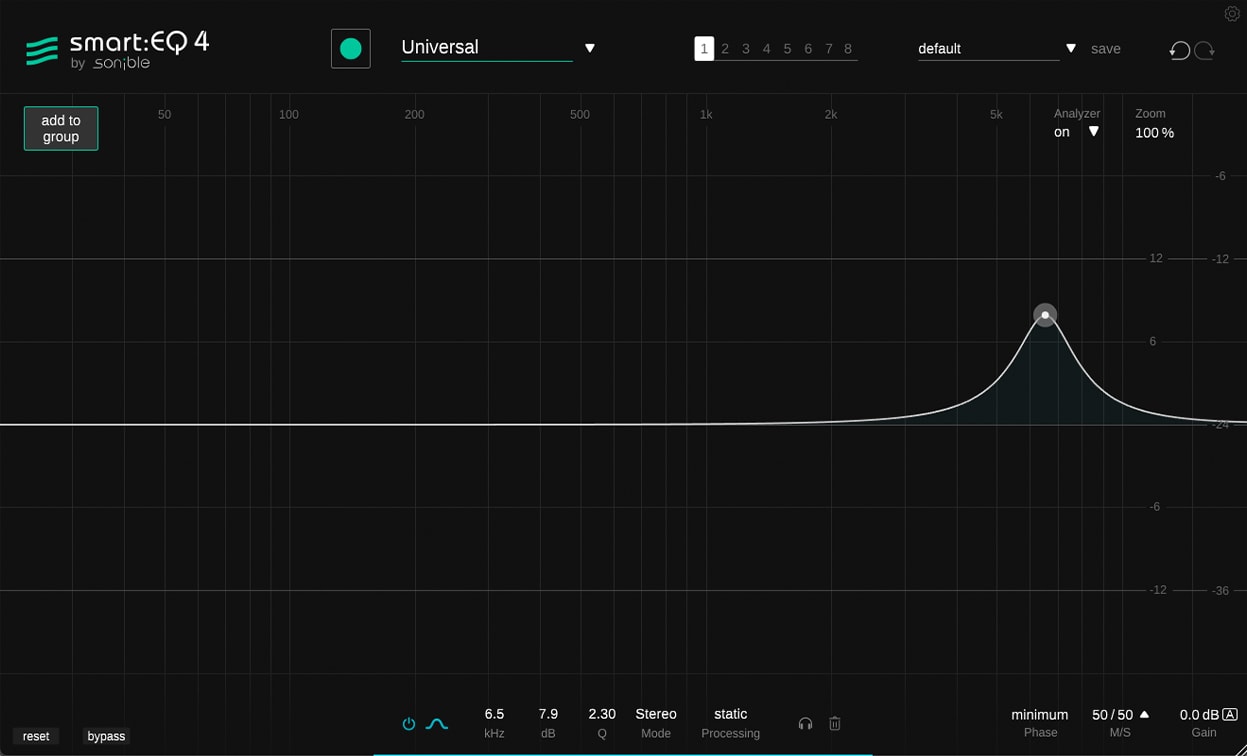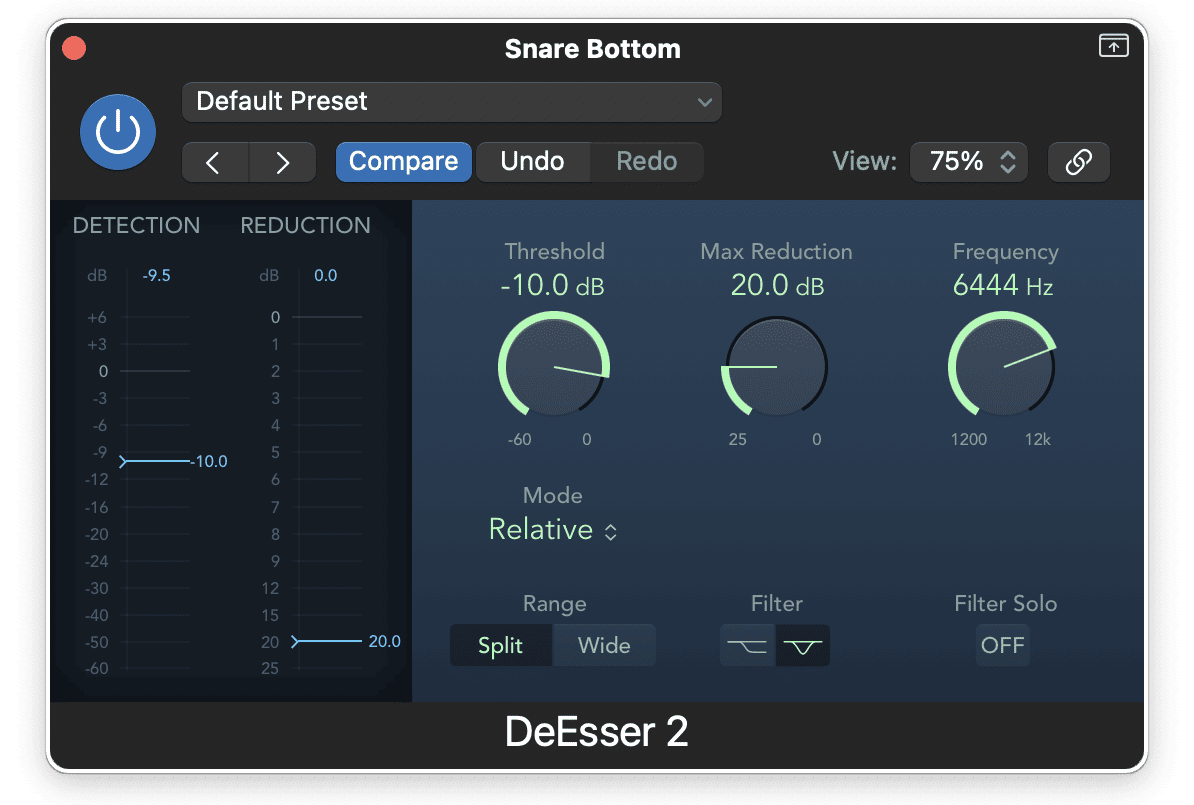Here’s how we’ve taken the de-esser up a level with our new AI-powered plugin smart:deess.
smart:deess is capable of performing tasks that traditional de-essers simply cannot. It is able to detect sibilance within recordings, shape their spectral character, and even remove plosives. But how?
In this article, we will explain how traditional de-essers work, how smart:deess works, and why we made the changes we have.
If you want to try out smart:deess for yourself you can now for free with our 30-day trial.
The de-esser has been around for several decades, and the concept dates back to the analog era of recording.
In the early days, engineers used hardware-based de-essers that were often rack-mounted units. These devices typically employed frequency-selective compression to attenuate the high-frequency components associated with sibilance.
As technology advanced, de-essers were also implemented as software plugins in the digital domain, although these followed the design philosophies and processing steps of their analog forerunners.
In the early days of popular music, the process of de-essing would often begin with the singer, not the engineer or producer. Professional singers such as Frank Sinatra were well microphone trained and would perform in order to reduce issues such as sibilance by changing their positioning relative to the microphone. There are even reports of John Lennon moving his hand between his mouth and microphone every time he sang an ess!
There are even reports of John Lennon moving his hand between his mouth and microphone every time he sang an ess!
Additionally, singers didn’t sing as close to the microphone as is common today. Singers would be a couple of feet away from the microphone diaphragm as opposed to the couple of inches that many singers record at now.
The equipment used in the 50s, 60s, 70s also had a part to play in de-essing recordings. In more recent decades the condenser mics which are typically used to record vocals have had their profiles tweaked to provide a boost in the upper mid frequencies. This provides the crisp sparkle you would associate with modern pop vocals, however, it also increases the prevalence of sibilance.
Despite good singer technique and different equipment, sibilance has always been a problem in vocal recordings, and producers did develop techniques to deal with it. One such technique was to sidechain a compressor with a signal of the vocal that has been boosted using an EQ in the sibilance range. The compressor would then apply broadband compression to the original vocal signal, but would only be triggered by frequencies occurring in the sibilant range.
One such technique was to sidechain a compressor with a signal of the vocal that has been boosted using an EQ in the sibilance range. The compressor would then apply broadband compression to the original vocal signal, but would only be triggered by frequencies occurring in the sibilant range.
Another method was to apply split band compression. With this method the vocal signal is split into two: a signal that contains the sibilant frequencies, and a signal that does not contain the sibilant frequencies. With this done, compression is applied to only the sibilant signal.
Nowadays we have dedicated de-essers that don’t require any signal splitting, sidechaining, or routing. All you have to do to de-ess a vocal is load a de-esser in your signal chain.
A traditional de-esser is essentially a compressor that is only triggered when its threshold is crossed within a very specific frequency range – the range in which sibilance occurs, typically 4 – 10 kHz.
When a traditional de-esser is triggered it applies broadband compression to the entire frequency spectrum. As with a compressor, de-essers typically give users control over the threshold value, the amount of gain reduction to be applied, and the speed of the reduction. Some de-essers also give control over the frequency range that triggers the de-esser. This is useful for de-essing voices with different frequency content, for example, male and female voices.
As with a compressor, de-essers typically give users control over the threshold value, the amount of gain reduction to be applied, and the speed of the reduction. Some de-essers also give control over the frequency range that triggers the de-esser. This is useful for de-essing voices with different frequency content, for example, male and female voices.
De-essers like this can be very effective, however, there are some limitations.
One issue with a traditional de-esser is that the de-esser is not actually detecting sibilance, instead, it is using energy in a specific frequency range as a proxy for the occurrence of sibilance.
This means that de-essers can be triggered by any loud sound in the sibilant frequency range which can mean compression can sometimes occur at unwanted times.
De-essers can be great at getting rid of sibilance in vocal recordings, but there are other unwanted sounds that can occur in vocal takes.
One of the most common and most destructive parts of vocal recordings is plosives. Plosives occur when pronouncing “bee” and “pee” sounds where a rush of air comes out of a singer’s mouth. This rush of air hits the diaphragm of the microphone causing it to vibrate. This vibration is translated into a bassy rumble in your audio recording.
Because plosives occur in a different part of the frequency spectrum to sibilance, traditional de-essers cannot remove plosives. This is one of the main advantages of our new AI powered smart:dees.
Another problem with traditional de-essers is that when they are triggered they perform broadband compression, reducing the volume across the entire frequency spectrum.
In an ideal world, de-essers would only be ducking the specific frequencies at which sibilance occurs.
smart:deess is sonible’s new AI powered de-esser, and with it, we are proud to introduce a range of new technologies that solve the problems of traditional de-esser plugins.
smart:deess doesn’t detect sibilance in the same way as traditional de-essers. With smart:deess we have implemented artificial intelligence into the detection algorithm. This allows smart:deess to analyse incoming audio and detect phonemes within the audio.
This is not based on volume or frequency range. smart:deess can identify sibilance within an audio recording from start to finish.
Because of this, smart:deess does not run into some of the problems that traditional de-essers do when it comes to getting triggered by sounds that are sibilant. Additionally, this also means that smart:deess can detect quiet instances of sibilance in a vocal recording that may not be picked up by a traditional de-eesser.
smart:deess doesn’t just detect sibilance with its AI powered phoneme detection. The algorithm can also pick up other unwanted sounds such as phonemes that occur in different parts of the audio frequency spectrum to sibilance. This includes plosives which are a very common problem in audio recording.
Because smart:deess is able to isolate these plosives, it is also then able to remove them from audio recordings.
smart:deess uses spectral processing to remove sibilance, plosives, and other unwanted elements from vocal recordings. Spectral processing works by dividing the frequency spectrum up into thousands of bands. You can think of it as very advanced multiband processing.
This means that – unlike traditional de-essers which duck the entire frequency spectrum as one – smart:deess only ducks the specific frequencies where these unwanted sounds occur. It will tackle different sibilant sounds in different ways – SS, SH, CH, P, T phonemes will each be processed uniquely.
Beyond just reducing the volume of sibilance, smart:dess allows you to reshape the color and tone of sibilant frequencies.
This is useful for a number of reasons. One unique use case is the ability to “re-ess”. If you have a voice recording that is a little dull, smart:deess gives you the ability to brighten sibilant frequencies, bringing them out more and adding more sparkle to your recording.
On the other hand, it’s also another tool in your de-essing arsenal. Rather than just ducking the volume of sibilance we can use the tone controls in smart:deess to darken the tone of the sibilance, making it less harsh.
Remember, if you want to try smart:deess for yourself and see how it can transform your de-essing workflow, it’s available to try for free for 30 days.
For more information on smart:deess, be sure to read our introduction to smart:deess.